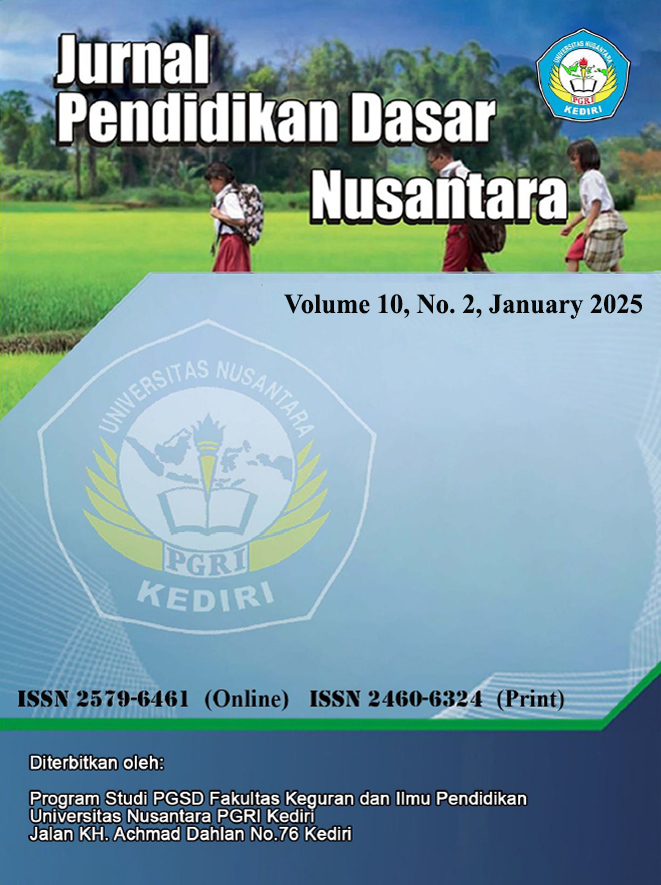The Development of Learning Media Based on Articulate Storyline 3 to Improve Numeracy Literacy Skills at SDN Kasembon 3 Kasembon District Malang Regency
DOI:
https://doi.org/10.29407/jpdn.v10i2.23777Keywords:
Literasi Numerasi, Learning Media, Articulate Storyline, Integer MaterialAbstract
Keterampilan matematika siswa sekolah dasar di Indonesia masih relatif di bawah tingkat yang diharapkan, khususnya pada materi pelajaran yang berhubungan dengan bilangan bulat. Tujuan penelitian ini adalah mengembangkan media pembelajaran literasi numerasi berbasis Articulate Storyline sebagai solusi pemecahan masalah pada materi bilangan bulat yang dapat dianggap valid menurut ahli media dan materi serta praktis menurut pengguna. Penelitian ini mengaplikasikan model ADDIE yang meliputi lima tahapan sebagai berikut: analisis, desain, pengembangan, implementasi, dan evaluasi. Subjek penelitian adalah guru dan siswa SDN 1 Kasembon dan SDN 3 Kasembon. Data diperoleh melalui observasi, wawancara dan kuesioner. Hasil uji validasi media literasi numerasi berbasis Articulate Storyline yang dilakukan oleh ahli dan pengguna menunjukkan bahwa rata-rata hasil keseluruhan dinilai sangat valid dan sangat praktis, memotivasi guru dan siswa, serta layak digunakan dalam pembelajaran.
Downloads
References
Asmara, S. D., & Purnomo, Y. W. (2023). Context of Data and Uncertainty: One of the Challenges for Numeracy Provision in Elementary School Teacher Education. Acta Scientiae, 25(6), 235–271. https://doi.org/10.17648/acta.scientiae.7276
Bennison, A., Goos, M., & Geiger, V. (2020). Utilising a research-informed instructional design approach to develop an online resource to support teacher professional learning on embedding numeracy across the curriculum. ZDM, 52(5), 1017–1031. https://doi.org/10.1007/s11858-020-01140-2
Branch, R. M. (2009). Instructional Design: The ADDIE Approach. Springer US. https://doi.org/10.1007/978-0-387-09506-6
Çankaya, E. A., Yıldız, E., & Cengiz, C. (2022). Examining Integers-Based Math Game Created by A Fourth Grade Student. Problems of Education in the 21st Century, 80(6), 750–764. https://doi.org/10.33225/pec/22.80.750
Daryanes, F., Darmadi, D., Fikri, K., Sayuti, I., Rusandi, M. A., & Situmorang, D. D. B. (2023). The development of articulate storyline interactive learning media based on case methods to train student’s problem-solving ability. Heliyon, 9(4), e15082. https://doi.org/10.1016/j.heliyon.2023.e15082
Erickson, D. C. (2020). Review of Articulate Storyline 360. Teaching Theology & Religion, 23(2), 135–136. https://doi.org/10.1111/teth.12534
Hendrix, N. M., Hojnoski, R. L., & Missall, K. N. (2020). Promoting Numeracy Skills Through Board Game Play. Young Exceptional Children, 23(2), 100–111. https://doi.org/10.1177/1096250618814239
Kemendikbudristek. (2023). Rapor Pendidikan 2022. Pusat Standar & Kebijakan Pendidikan. https://pskp.kemdikbud.go.id/rapor_pendidikan
Lee, H. K., & Choi, A. (2020). Enhancing early numeracy skills with a tablet-based math game intervention: A study in Tanzania. Educational Technology Research and Development, 68(6), 3567–3585. https://doi.org/10.1007/s11423-020-09808-y
Lestarani, D., Lalang, A. C., & Manggi, I. (2023). Development of Articulate Storyline 3-Based Digital Teaching Materials on the Subject of Atomic Structure and Periodic Elements System for SMA/MA Students in Class X. Orbital: The Electronic Journal of Chemistry, 127–132. https://doi.org/10.17807/orbital.v15i2.17959
Muhaimin, L. H., Dasari, D., & Kusumah, Y. S. (2023). Numeracy-Ability, Characteristics of Pupils in Solving the Minimum Competency Assessment. AKSIOMA: Jurnal Program Studi Pendidikan Matematika, 12(1), 697–707. https://doi.org/10.24127/ajpm.v12i1.6396
Nissa, A. D. A., Toyib, M., Sutarni, S., Akip, E., Kadir, S., Ahmad, & Solikin, A. (2021). Development of Learning Media Using Android-Based Articulate Storyline Software for Teaching Algebra in Junior High School. Journal of Physics: Conference Series, 1720(1), 012011. https://doi.org/10.1088/1742-6596/1720/1/012011
OECD. (2023). PISA 2022 Results (Volume I): The State of Learning and Equity in Education. OECD Publishing. https://www.oecd.org/publication/pisa-2022-results/
Pratiwi, K. I. A., Margunayasa, I. G., & Trisna, G. A. P. S. (2023). Project-Based Learning Interactive Multimedia with Orientation of Environmental Problems Assisted by Articulate Storyline 3 for Grade V Elementary Schools. Journal of Education Technology, 7(2), Article 2. https://doi.org/10.23887/jet.v7i2.59615
Ramadhan, D. N., Hermawan, H. D., & Septiyanti, N. D. (2023). Implementasi dan Pengembangan Media Pembelajaran Game Calistung untuk Meningkatkan Literasi dan Numerasi di SD N 04 Kemuning. Jurnal Ilmiah Kampus Mengajar, 13–25. https://doi.org/10.56972/jikm.v3i1.81
Sakerani, Prastitasari, H., Purwanti, R., Ramadhani, T. A., Rizqieya, Hasanah, N. F., & Rahmah, S. N. (2022). Development of Wetland-Based Teaching Materials to Improve English Vocabulary, Reading Literacy Skills, Early Childhood Numeracy and Elementary School. International Journal of Social Science and Human Research, 5(9), 4315–4322. https://doi.org/10.47191/ijsshr/v5-i9-44
Singh, P., Hoon, T. S., Nasir, A. M., Ramly, A. M., Rasid, S. M., & Meng, C. C. (2021). Card game as a pedagogical tool for numeracy skills development. International Journal of Evaluation and Research in Education (IJERE), 10(2), 693. https://doi.org/10.11591/ijere.v10i2.20722
Thomas, A., Tazouti, Y., Hoareau, L., Luxembourger, C., Hubert, B., & Jarlégan, A. (2023). Early Numeracy Assessment In French preschool: Structural analysis and links with children’s characteristics. International Journal of Early Years Education, 31(4), 1018–1035. https://doi.org/10.1080/09669760.2021.1938518
Zaenal, R. M., Suryaman, O., & Sutisna, A. (2022). Pengembangan Media Pembelajaran Mobile Learning “Numet” untuk Meningkatkan Kemampuan Numerasi Siswa Sekolah Dasar. AKSIOMA: Jurnal Program Studi Pendidikan Matematika, 11(4), 2725. https://doi.org/10.24127/ajpm.v11i4.6035
Downloads
Published
Issue
Section
License
Copyright (c) 2025 Radeni Sukma Indra Dewi, Widiyanti Widiyanti, Lismi Animatul Chisbiyah, Ratna Ekawati, Mohammad Yusuf Randy, Dilla Alfi Fatiha, Fikha Anggraini Asih Pramesti, Nurrizka Arina Rosyada (Author)

This work is licensed under a Creative Commons Attribution-ShareAlike 4.0 International License.
Authors who publish with this journal agree to the following terms:
- Copyright on any article is retained by the author(s).
- The author grants the journal, the right of first publication with the work simultaneously licensed under a Creative Commons Attribution License that allows others to share the work with an acknowledgment of the work’s authorship and initial publication in this journal.
- Authors are able to enter into separate, additional contractual arrangements for the non-exclusive distribution of the journal’s published version of the work (e.g., post it to an institutional repository or publish it in a book), with an acknowledgment of its initial publication in this journal.
- Authors are permitted and encouraged to post their work online (e.g., in institutional repositories or on their website) prior to and during the submission process, as it can lead to productive exchanges, as well as earlier and greater citation of published work.
- The article and any associated published material is distributed under the Creative Commons Attribution-ShareAlike 4.0 International License
































